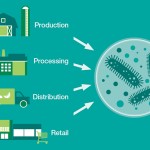Just how can genomics, specifically microbiomics, play a pivotal role in FSMA compliance?
Microbiomes may be particularly suited as a testing program for validation and verification of process controls, sanitation controls and supply-chain controls. Samples for microbiome analyses can include ingredients, in-process material, finished product and environmental testing. Because food safety systems change with time, knowing the impact of such changes on evolution of a facility microbiome can be a critical factor in ensuring the success of the food safety plan. This becomes increasingly important when a company changes suppliers, process or product. Such changes can alter hazards and associated risks by selecting for or against populations of desirable or undesirable microbes. Microbiomes also are helpful in defining risks when companies experience unanticipated problems, recurring deviations, or when a preventative control is known to be ineffective. Microbiomes may further shed light on the risks of distribution system abuses and new, unexpected or anticipated consumer use and misuse of a product. Should new scientific information be discovered that leads to doubts of the effectiveness of a preventative control measure, microbiomes can be used to both qualitatively and quantitatively reassess risk.
For companies with a well-established food safety plans, microbiomes are ideally suited to generate data that informs reanalysis of plan effectiveness. By coupling targeted pathogen testing with microbiomes, a full picture of the microbial community in a facility can be developed. To accomplish this task, we recommend an initial baseline microbiome screen of ingredients, products and sensitive areas in the processing environment. Both regular microbiome screens and microbiome screens following ingredient, process or product changes should be carried out. Particularly powerful is conducting a before and after intervention microbiome to compare intervention effectiveness on the total microbiota of the sample over the intended shelf life of the product. Coupling microbiome data with traditional indicator and pathogen testing provides knowledge of the behavior of microbial populations in a facility.
A reminder that microbiomes are not substitutes for targeted pathogen testing. If a food safety plan hazard analysis clearly identifies Salmonella, Listeria monocytogenes, or other pathogen as reasonably foreseeable then specific validation and verification testing for such hazards is essential to ensure that preventative controls are working. Also, microbiomes have little utility for allergens needing control.
In summary, validation demonstrates that the food safety plan will effectively control the identified hazards and verification demonstrates that the food safety plan is properly implemented by those involved. In future columns we will provide examples of the use of advances genomics to ensure FSMA compliance. Always fell free to write us with any questions or comments.
Next month’s installment: How is DNA Sequenced?








